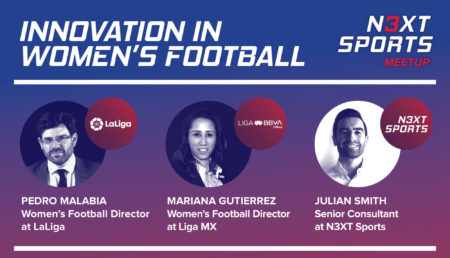
2019 was a landmark year for women’s football with the success of the 2019 FIFA Women’s World Cup from audience viewership, to in-game attendance, to sponsorship opportunities, and social media engagement.
¨To be able to keep the momentum going, clubs and national federations have to work together with different stakeholders to make sure that the industry keeps growing and that people pay attention to women’s football every day, rather than every four years.¨
At the recent N3XT Sports online Meetup about Innovation in Women’s football, we hosted Mariana Gutierrez, Women’s Football Director at Liga MX and Pedro Malabia, Women’s Football Director at LaLiga. We dug into several topics including the state of women’s football in countries like Spain and Mexico, the recent establishment of women’s football leagues across different geographies, and the opportunities that this presents. The underlying commercial and operational infrastructure related to the league opens up opportunities in fan engagement, sponsorship categories, media & distribution, as well as the development aspect of the game.
¨Women’s football has become a new asset for many different stakeholders. Even though it’s the same sport as men’s football, women’s football is a different industry.¨ – Mariana Gutierrez
The key for women’s football is to work day by day on understanding what the industry can offer, and what can be done to develop it. Women’s football, like men’s football, not only competes in the sports industry but also in the entertainment industry, which means fans are a huge priority.
¨Women’s football should aim towards establishing the best they can reach and that can be very high and should not be compared to reaching the level of men’s football.¨– Pedro Malabia
As we look at the growth of the women’s game globally, to build an attractive product to the fans, and to bring new value to partners, sponsors, and broadcasters, innovation and technology should play a leading role in the conversation. Innovation is all about experimenting, challenging the status quo, and developing novel business models to grow the industry. That could be from a boardroom perspective, or on the pitch on the field of play.
The women’s game can be a fertile ground to experiment with new endeavors and test innovative ideas for relatively low investment when compared to men’s football with lower business risks given the context. That creates a unique opportunity for technology companies to enter into key strategic markets.
We heard from Mariana how CITEC works with Liga MX Femenil to provide every club with tools that enhance training sessions and match analysis, as well as provide deeper insights into individual player performance. Cameras are set up in all stadiums and practice fields that provide automated video clips that are then uploaded into Wyscout, the biggest scouting platform in the world.
¨We need to better understand the athletes, the women’s athletes body and what variables in their performance we need to analyze in order to exploit them to reach their full potential, that’s why we are fully committed to investing in technology to improve our player’s performance.¨
LaLiga has supported the development of broadcasting of women’s football matches, becoming the first league ever to broadcast with sky cameras. LaLiga invested in this because it was important to give an added value to women’s football, enhancing the audience’s experience with the product. LaLiga experimented during a scrimmage game by implementing small cameras affixed to the shirts of the goalkeepers, giving the audience the on-pitch perspective broadcasting experience, taking in different angles of the game previously unseen.
From a sponsorship perspective, simple signage is no longer enough. Partners and sponsors require digital activation, and detailed fan insights that can help create new hyper personalized experiences. BBVA, as the title partner of Liga MX for both the men’s and women’s competitions, has been helping the league to grow on a global scale, to create new products and experiences around women’s football, and to attract new audiences. The way LaLiga in Spain approached its title partner, energy company Iberdrola, was not about big broadcasting figures or big attendance numbers on match day,
¨…it was more about building role models, integrating with women in society, and seeing the value and the potential of women’s football.¨ – Pedro Malabia
Realizing the value now while still in a relatively early stage of global women’s football development can provide partners with a first-mover advantage and a potentially big reward both financially and in cultural value as well.
We are looking forward to seeing how women’s football keeps developing and growing its own industry:
¨In the next 2-3 years, we can expect to have a more structured format, being able to open the league for foreign players, develop a youth program, and build an international cup competition in order to understand where we are and to step up to another level.¨– Mariana Gutierrez
We hope to see further recognition from the ecosystem of the importance of bringing the whole spectrum of stakeholders into developing football generally and the women’s game in particular.
Does your organization have an innovation strategy in place? Where are you in your journey? Want to find out? Get in touch with our teammate Javier at javier@n3xtsports.com to find out more about some of our turnkey innovation strategy projects.
If you were not able to make it to our online session, you can watch it here, also we would like to invite you to subscribe to our newsletter, and follow us on Linkedin, Twitter, and Facebook to stay up to date with any N3XT Sports news.



